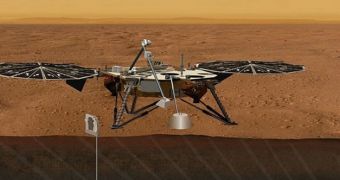A group of experts is proposing the creation of a new spacecraft that would fly to Mars, which would use technologies cannibalized from a number of other missions that already visited the Red Planet.
Originally, the new project was called the Geophysical Monitoring Station (GMS), but now there's no name attached to it. The spacecraft itself would be a lander, rather than a rover, and would feature the ability to burrow deep into Martian soil.
From the Mars Surveyor 98 spacecraft, the GMS would take an advanced seismometer instrument, while the British Beagle 2 mission would provide the burrowing device. As much as 77 percent of the lander would be based on NASA Phoenix Mars Lander.
Another 20 percent of the vehicle would bear close resemblance to Phoenix, leaving just 3 percent of the new lander to be constructed from scratch, experts say. Using this approach, the team that proposed the mission managed to obtain a potent tool with only minimal costs.
The Martian geological record spans more than 4 billion years into the past. The planet is of the terrestrial class, which means that studying its pristine environment could lead to more insights into how Earth itself developed in the early days of the solar system.
“Mars is not an easy place to land on, but we've done it a number of times. We're going to try and do it exactly like how we did it with Phoenix a few years ago,” said planetary scientist Bruce Banerdt, who holds an appointment at the Jet Propulsion Laboratory (JPL), in Pasadena, California.
Our neighboring planet is “big enough to have undergone the same early processes during the first few hundred million years that Earth has undergone, but small enough so that the clues to those processes are still there,” Banerdt added.
He made the statement in front of colleagues attending the 9th IAA Low-Cost Planetary Missions Conference, which was held in Laurel, Maryland on June 22. The purpose of the new mission would be to analyze the size, composition and state of the Martian core.
This is a Discovery-class mission, so experts are competing with two other proposals for a $425 million grant. If selected, the new platform could take off as early as March 2016, and arrive at Mars by September 2016.
The second accepted proposal is the Titan Mare Explorer (TiME). This mission is also a lander, but one that will descend, and then made to float, on the liquid hydrocarbon oceans of Saturn's moon Titan.
Such a mission would represent the first time that a spacecraft is sent to explore an ocean that is not on Earth. Titan is shaping up to be one of the most interesting targets of exploration in the solar system. Even if TiME is not selected, a mission will eventually be sent there.
In the third proposal, experts at the NASA Goddard Space Flight Center, in Greenbelt, Maryland, would manage the Comet Hopper spacecraft. This probe would land on a comet multiple times, and study the evolution of such space bodies as it does so, Space reports.
“This is high science return at a price that's right. The selected studies clearly demonstrate a new era with missions that all touch their targets to perform unique and exciting science,” said the director of the NASA Planetary Science Division, Jim Green.

 14 DAY TRIAL //
14 DAY TRIAL //